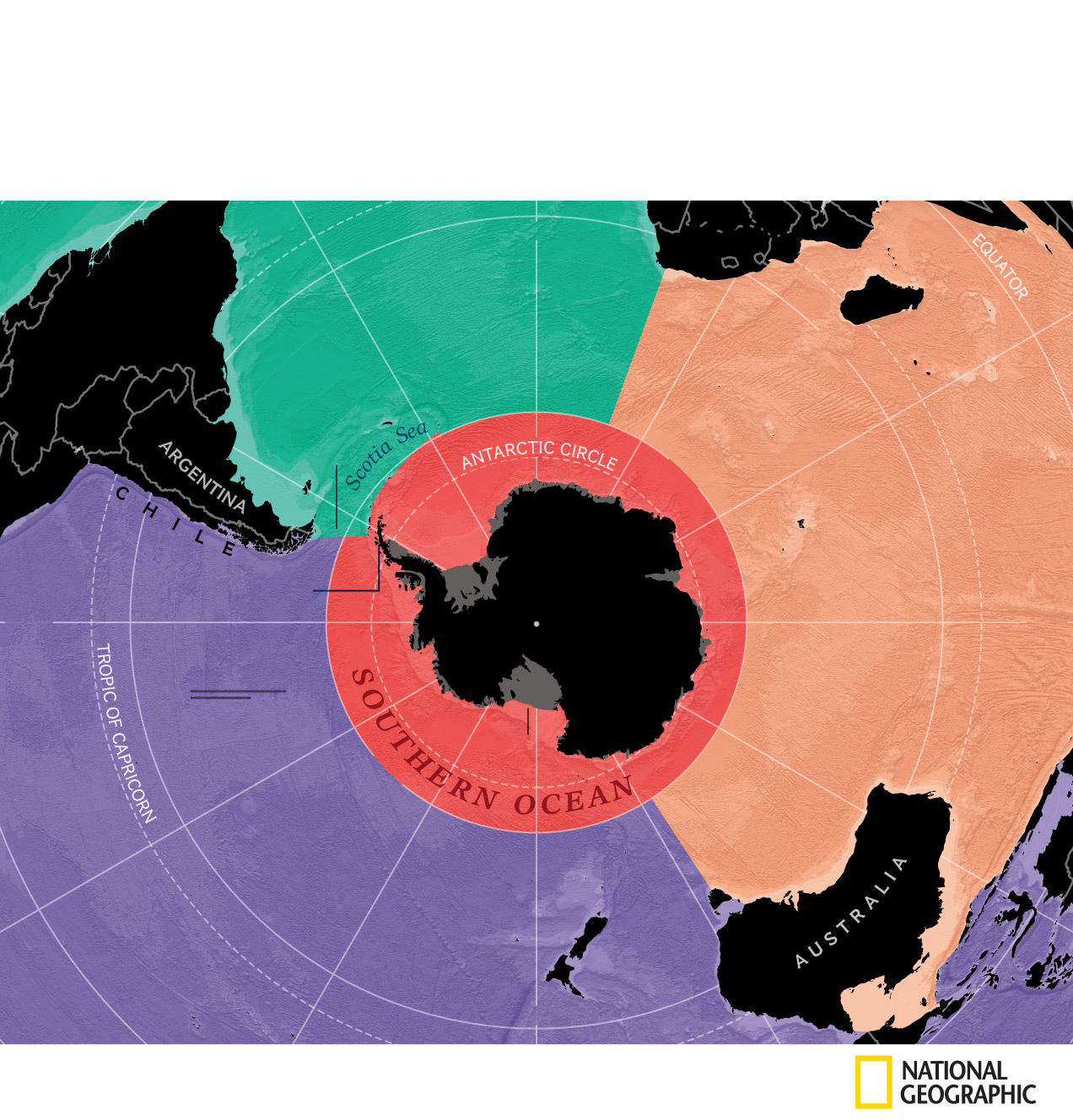The Southern Ocean
:: The Watch Tower :: Satellite V
Page 1 of 1
 The Southern Ocean
The Southern Ocean
So i'm about a year and half behind, as of June 2021 we now have 5 Oceans 
The Oceans of the world:
The Atlantic, Pacific, Indian, Arctic and.. The Southern Ocean
The Oceans of the world:
The Atlantic, Pacific, Indian, Arctic and.. The Southern Ocean
NationalGeographic.com wrote:There’s a new ocean now—can you name all 5?
On World Oceans Day, Nat Geo cartographers say the swift current circling Antarctica keeps the waters there distinct and worthy of their own name: The Southern Ocean.
*By Sarah Gibbens
Those familiar with the Southern Ocean, the body of water encircling Antarctica, know it’s unlike any other.
“Anyone who has been there will struggle to explain what's so mesmerizing about it, but they'll all agree that the glaciers are bluer, the air colder, the mountains more intimidating, and the landscapes more captivating than anywhere else you can go,” says Seth Sykora-Bodie, a marine scientist at the National Oceanic and Atmospheric Administration (NOAA) and a National Geographic Explorer.
Since National Geographic began making maps in 1915, it has recognized four oceans: the Atlantic, Pacific, Indian, and Arctic Oceans. Starting on June 8, World Oceans Day, it will recognize the Southern Ocean as the world’s fifth ocean.
“The Southern Ocean has long been recognized by scientists, but because there was never agreement internationally, we never officially recognized it,” says National Geographic Society Geographer Alex Tait.
*South Pole
Matthew W. Chwastyk, and Soren Walljasper, NGM Staff. Eric Knight
Sources: NASA/JPL; Green Marble
Geographers debated whether the waters around Antarctica had enough unique characteristics to deserve their own name, or whether they were simply cold, southern extensions of the Pacific, Atlantic, and Indian Oceans.
“It’s sort of geographic nerdiness in some ways,” Tait says. He and the National Geographic Society’s map policy committee had been considering the change for years, watching as scientists and the press increasingly used the term Southern Ocean.
The change, he adds, aligns with the Society’s initiative to conserve the world’s oceans, focusing public awareness onto a region in particular need of a conservation spotlight.
“We’ve always labeled it, but we labeled it slightly differently [than other oceans],” Tait says. “This change was taking the last step and saying we want to recognize it because of its ecological separation.”
Marine biologist and National Geographic Explorer at Large Sylvia Earle praised the cartographic update.
“While there is but one interconnected ocean, bravo to National Geographic for officially recognizing the body of water surrounding Antarctica as the Southern Ocean,” Earle wrote in an e-mailed statement. “Rimmed by the formidably swift Antarctic Circumpolar Current, it is the only ocean to touch three others and to completely embrace a continent rather than being embraced by them.”An environment like no other
For now, by fencing in the frigid southern waters, the ACC helps keep Antarctica cold and the Southern Ocean ecologically distinct. Thousands of species live there and nowhere else.
The Southern Ocean “encompasses unique and fragile marine ecosystems that are home to wonderful marine life such as whales, penguins, and seals,” notes National Geographic Explorer in Residence Enric Sala.
What’s more, the Southern Ocean has ecological effects elsewhere as well. Humpback whales, for example, feed on krill off Antarctica and migrate far north to winter in very different ecosystems off South and Central America. Some seabirds migrate in and out too.
By drawing attention to the Southern Ocean, the National Geographic Society hopes to promote its conservation.Mapping the world as it is
Since the late 1970s, the National Geographic Society has employed a geographer who oversees changes and tweaks to every map that’s published. Tait has been on the job since 2016.
He says he takes a journalist’s approach to the process. It involves staying on top of current events and monitoring who controls what areas of the world.
“It is important to note it’s a map policy, not a policy about Nat Geo’s position on [geopolitical] disputes,” he says. For example, National Geographic maps show that the U.K. controls the Falkland Islands, even though Argentina claims them too. In disputed areas, Tait works with a team of geographers and editors to determine what most accurately represents a given region.
Minor changes happen on a weekly or biweekly basis. Major changes, like labeling the Southern Ocean, are more rare.
“I think one of the biggest impacts is through education,” he says. “Students learn information about the ocean world through what oceans you’re studying. If you don’t include the Southern Ocean then you don’t learn the specifics of it and how important it is.”
Read the full/original article at: https://www.nationalgeographic.com/environment/article/theres-a-new-ocean-now-can-you-name-all-five-southern-ocean

Bad Wolf- Designer GFX

-


Level : 46
Number of posts : 3391
Location : Satellite V
Rank : 7
Experience : 3014
Registration Date : 2006-12-24
Cprofile
Title: The Digital Alchemist
Luck:


 (588/588)
(588/588)
Karma:


 (530/777)
(530/777) -

:: The Watch Tower :: Satellite V
Page 1 of 1
Permissions in this forum:
You cannot reply to topics in this forum




